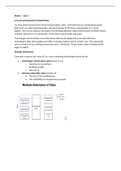Week 1 – day 1
S-Curves and personal transportation
For thousands of years horse driven transportation. Only ~1900 the first cars started being made.
Both total cars sold/world population and performance in HP show a exponential or S-curved
pattern. The S-curve shows in all graphs of technology diffusion where performance VS effort/money
invested. Slow first as it is unfamiliar, in the end it reaches limits and stops.
Technologies do not always reach their limits and may be displaced by new discontinuous
technologies. New technologies can fulfill an existing market need in a better way, thus improving
upon current S-curves, making the previous ones ‘unfinished’. Those factors make incumbent firms
eager to switch.
Multiple Dimensions
Customers compare the value of 2 or more competing technologies based on the
Technology’s Stand-alone value based on e.g.
o Functions in can perform
o Aesthetic quality
o Ease of use
Network externality value function of
o The size of the installed base
o The availability of complementary goods
,Week 1 – Book chapter 3 – Types and Patterns of Innovation
The path a technology follows through time is termed its technology trajectory. This trajectory is
usually used to represent a technology’s rate of performance improvement/rate of adoption in the
marketplace.
The 4 types of dimensions used to categorize innovations the most are:
Product VS Process innovation: Product innovations are embodied in the outputs of an
organization. Process innovations are in the way an organization conducts its business, often
orientated towards effectiveness/efficiency. They usually happen together.
Radical VS Instrumental innovation: radicalness can be defined in terms of
o Newness/differentness
o Risk
o Relativeness: what is radical may change over time/with different observers
Competence enhancing VS Competence destroying innovation: an innovation is
competence enhancing when it builds on the existing knowledge base/competencies of the
firm, making them more valuable. An innovation is competence destroying when it does not
build on the firm’s existing competencies or renders them obsolete, example calculators.
Architectural VS component/modular innovation: an innovation is considered a
component/modular innovation if it entails changes to one or more components, but does
not significantly affect the overall configuration of the system, e.g. innovation in bike seat
doesn’t require any changes in the rest of the bike architecture. In contrast architectural
innovation entails changing the overall design of the system or the way components interact
with each other, without changing the components itself. For a firm to initiate component
innovation knowledge about that component only is enough. For architectural innovation
knowledge about the entire system is needed.
S-shaped curves in technology performance and technology diffusion are related, but they are
fundamentally different processes.
S-curves in technological improvement are performance VS amount of effort/money. In early stages
performance improvement is slow due to the fundamentals of technology being poorly understood.
Furthermore until the technology has established a degree of legitimacy, it may be difficult to attract
researchers. Eventually diminishing returns set in as
cost of marginal improvement increases and the
technology reaches its limits.
If performance is plotted against time and the effort
invested is not constant over time, the S-curve
might appear different.
Technologies do not always reach their limits, they
may be rendered obsolete by new discontinuous
technologies: they fulfill a similar market need but
by building on an entirely new knowledge base.
If the disruptive technology has a steeper S-curve or
an S-curve that increases to a higher performance
limit, returns to effort invested are higher for the
new than for the incumbent technology.
,S-curves in technology diffusion are obtained by plotting the cumulative number of adopters of the
technology against time. This is S-shaped because more people adopt as it as better understood and
eventually the market is saturated.
Technology diffusion generally takes far more time than information diffusion. This might be due to
the complexity of knowledge and it being tacit, thus requiring person to person contact. Also many
technologies only become available to users if there is a set of complementary resources too.
S-curves in diffusion are in part a function of s-curves in technology improvement: as technologies
are better developed, they become more certain and useful to users and cheaper.
S-curves can also be used as a prescriptive tool to predict when a technology will reach its limits and
if a firm should move to a new technology. There are however some limitations:
It is rare that the true limits of a technology are known in advance
The shape of a technology’s S-curve is undefined
Firms can influence the shape of a S-curve through development
Whether switching to a new technology will benefit a firm depends on:
The advantages offered by the new technology
The new technology’s fit with the firm’s current abilities
The new technology’s fit with the firm’s position in complementary resources
The expected rate of diffusion of the new technology
The s-curve model suggests that technological change is cyclical. The emergence of a new
technological discontinuity can overturn the existing competitive structure of an industry creating
new winners and losers: what Schumpeter calls creative destruction. He argued this is the key driver
of progress in a capitalist society.
One technology evolution model proposed by Utterback and Abernathy stated technology passes
through several distinct phases:
1. Fluid phase: considerable uncertainty about both the technology and market. Firms but
eventually a dominant design emerges.
2. Specific phase: the dominant design enables firms to focus their efforts on process
innovations to increase efficiency.
Anderson and Tushman found that each technological discontinuity inaugurated a period of
turbulence and uncertainty: the era of ferment. During this era different stakeholders might have
different concepts of what purpose the technology should serve/what the business model is like.
While substitution happens there is considerable design competition: a dominant design always
arises unless the next discontinuity arrives too soon and disrupts the cycle. Anderson also found the
dominant design is never in the same form as the original discontinuity and never on the
leading edge of the technology. The dominant design is a combination of features.
The rise of the dominant design signals the transition from the era of ferment to the era of
incremental change where firms focus on efficiency and market penetration and try to
lower production costs. This continuous until the next cycle starts.
Most competition revolves around improving components rather than altering architecture.
As everything starts to revolve around the dominant design, a firm becomes less able to
react to a new architecture.
, Rogers proposed 5 adopter strategies of the diffusion S-curve:
1. Innovators: typically have access to substantial financial
resources. They bring new ideas into the social system.
Approximately the first 2,5%
2. Early adopters: greatest potential for opinion
leadership. Respected by their peers. Other adopters
look to them for advice. Approximately next 13,5%
3. Early majority: not opinion leaders but frequent interaction with peers. Next 34%
4. Late majority: approach innovation skepticly, only adopt with peer pressure. Have scarce
resources. Next 34%
5. Laggards: base their decision mostly on past experience instead of social network. Highly
skeptical. Last 16%
Chapter 4 – Standards Battles, Modularity and Platform Competition
Dominant design. A single product or process architecture that dominates a product category -
usually 50 percent or more of the market. A dominant design is a de facto standard meaning that
while it may not be officially enforced/acknowledged, it has become a standard for the industry.
Increasing returns. When the rate of return (not just gross returns) from a product or process
increases with the size of the installed base.
Markets coalesce around a single dominant design due to:
Increasing returns to adoption, the more a technology is adopted, the more valuable it
becomes
As it is used, greater understanding of the design which enables improvements occurs
As it is more widely adopted, complementary assets are developed
This results in a self-enforcing mechanism that increases dominance. 2 primary sources of increasing
returns are:
Learning effects. The more a technology is used, the more it is developed and the more
effective and efficient it becomes. One example of learning effects is shown in the impact of
cumulative production on cost and productivity also known as the learning curve.
Performance increases and cost decreases. The standard form of the learning curve is y = ax -b
where y = #direct labour hours required to produce the xth unit, a is the #direct labour hours
to produce the first unit, x the cumulative number of units produced and b the learning rate.
The learning rate can be influenced by the nature of the task, firm strategy and the firm’s
prior experience
o A firm’s investment in prior learning can accelerate its rate of future learning by
building the firm’s absorptive capacity: the ability of an organization to recognize,
assimilate and utilize new knowledge. The more firms that are using a given
technology and refining it, the more absorptive capacity us being generated.







